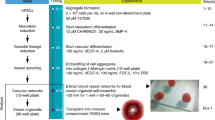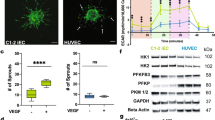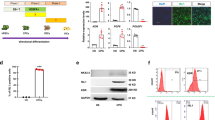Abstract
Pluripotent human embryonic stem cells (hESCs) differentiate into most of the cell types of the adult human body, including vascular cells. Vascular cells, such as endothelial cells and vascular smooth muscle cells (SMCs) are significant contributors to tissue repair and regeneration. In addition to their potential applications for treatment of vascular diseases and stimulation of ischemic tissue growth, it is also possible that endothelial cells and SMCs derived from hESCs can be used to engineer artificial vessels to repair damaged vessels and form vessel networks in engineered tissues. Here we review the current status of directing hESCs to differentiate to vascular cells.
This is a preview of subscription content, access via your institution
Access options
Subscribe to this journal
Receive 12 print issues and online access
$259.00 per year
only $21.58 per issue
Buy this article
- Purchase on Springer Link
- Instant access to full article PDF
Prices may be subject to local taxes which are calculated during checkout


Similar content being viewed by others
References
Thomson JA, Itskovitz-Eldor J, Shapiro SS, Waknitz MA, Swiergiel JJ, Marshall VS et al. Embryonic stem cell lines derived from human blastocysts. Science 1998; 282: 1145–1147.
Pardanaud L, Yassine F, Dieterlen-Lievre F . Relationship between vasculogenesis, angiogenesis and haemopoiesis during avian ontogeny. Development 1989; 105: 473–485.
Sabin FR . Studies on the origin of blood vessels and of red corpuscles as seen in the living blastoderm of the chick during the second day of induction. Contribut Embryol 1920; 9: 213–262.
Wagner RC . Endothelial cell embryology and growth. Adv Microcirc 1980; 9: 45–75.
Barker JE . Development of the mouse hematopoietic system I. Types of hemoglobin produced in embryonic yolk sac and liver. Dev Biol 1968; 18: 14–29.
Brotherton TW, Chui DH, Gauldie J, Patterson M . Hemoglobin ontogeny during normal mouse fetal development. Proc Natl Acad Sci USA 1979; 76: 2853–2857.
Risau W . Mechanisms of angiogenesis. Nature 1997; 386: 671–674.
Palis J, Yoder MC . Yolk-sac hematopoiesis: the first blood cells of mouse and man. Exp Hematol 2001; 29: 927–936.
Tavian M, Hallais MF, Peault B . Emergence of intraembryonic hematopoietic precursors in the pre-liver human embryo. Development 1999; 126: 793–803.
Jaffredo T, Gautier R, Eichmann A, Dieterlen-Lievre F . Intraaortic hemopoietic cells are derived from endothelial cells during ontogeny. Development 1998; 125: 4575–4583.
Nishikawa SI, Nishikawa S, Kawamoto H, Yoshida H, Kizumoto M, Kataoka H et al. In vitro generation of lymphohematopoietic cells from endothelial cells purified from murine embryos. Immunity 1998; 8: 761–769.
North TE, de Bruijn MF, Stacy T, Talebian L, Lind E, Robin C et al. Runx1 expression marks long-term repopulating hematopoietic stem cells in the midgestation mouse embryo. Immunity 2002; 16: 661–672.
Eichmann A, Corbel C, Le Douarin NM . Segregation of the embryonic vascular and hemopoietic systems. Biochem Cell Biol 1998; 76: 939–946.
Pardanaud L, Luton D, Prigent M, Bourcheix LM, Catala M, Dieterlen-Lievre F . Two distinct endothelial lineages in ontogeny, one of them related to hemopoiesis. Development 1996; 122: 1363–1371.
Carmeliet P . Mechanisms of angiogenesis and arteriogenesis. Nat Med 2000; 6: 389–395.
Tomanek RJ . Formation of the coronary vasculature during development. Angiogenesis 2005; 8: 273–284.
ten Dijke P, Korchynskyi O, Valdimarsdottir G, Goumans M-J . Controlling cell fate by bone morphogenetic protein receptors. Mol Cell Endocrinol 2003; 211: 105–113.
Reubinoff BE, Pera MF, Fong CY, Trounson A, Bongso A . Embryonic stem cell lines from human blastocysts: somatic differentiation in vitro. Nat Biotechnol 2000; 18: 399–404.
Strelchenko N, Verlinsky O, Kukharenko V, Verlinsky Y . Morula-derived human embryonic stem cells. Reprod Biomed Online 2004; 9: 623–629.
Evans MJ, Kaufman MH . Establishment in culture of pluripotential cells from mouse embryos. Nature 1981; 292: 154–156.
Axelrod HR . Embryonic stem cell lines derived from blastocysts by a simplified technique. Dev Biol 1984; 101: 225–228.
Wobus AM, Holzhausen H, Jakel P, Schoneich J . Characterization of a pluripotent stem cell line derived from a mouse embryo. Exp Cell Res 1984; 152: 212–219.
Doetschman TC, Eistetter H, Katz M, Schmidt W, Kemler R . The in vitro development of blastocyst-derived embryonic stem cell lines: formation of visceral yolk sac, blood islands and myocardium. J Embryol Exp Morphol 1985; 87: 27–45.
Williams RL, Hilton DJ, Pease S, Willson TA, Stewart CL, Gearing DP et al. Myeloid leukaemia inhibitory factor maintains the developmental potential of embryonic stem cells. Nature 1988; 336: 684–687.
Ludwig TE, Levenstein ME, Jones JM, Berggren WT, Mitchen ER, Frane JL et al. Derivation of human embryonic stem cells in defined conditions. Nat Biotechnol 2006; 24: 185–187.
Ying Q-L, Nichols J, Chambers I, Smith A . BMP induction of id proteins suppresses differentiation and sustains embryonic stem cell self-renewal in collaboration with STAT3. Cell 2003; 115: 281–292.
Xu RH, Peck RM, Li DS, Feng X, Ludwig T, Thomson JA . Basic FGF and suppression of BMP signaling sustain undifferentiated proliferation of human ES cells. Nat Methods 2005; 2: 185–190.
Schuldiner M, Yanuka O, Itskovitz-Eldor J, Melton DA, Benvenisty N . From the cover: effects of eight growth factors on the differentiation of cells derived from human embryonic stem cells. Proc Natl Acad Sci USA 2000; 97: 11307–11312.
Itskovitz-Eldor J, Schuldiner M, Karsenti D, Eden A, Yanuka O, Amit M et al. Differentiation of human embryonic stem cells into embryoid bodies compromising the three embryonic germ layers. Mol Med 2000; 6: 88–95.
Sjogren-Jansson E, Zetterstrom M, Moya K, Lindqvist J, Strehl R, Eriksson PS . Large-scale propagation of four undifferentiated human embryonic stem cell lines in a feeder-free culture system. Dev Dyn 2005; 233: 1304–1314.
Kehat I, Kenyagin-Karsenti D, Snir M, Segev H, Amit M, Gepstein A et al. Human embryonic stem cells can differentiate into myocytes with structural and functional properties of cardiomyocytes. J Clin Invest 2001; 108: 407–414.
Zhang SC, Wernig M, Duncan ID, Brustle O, Thomson JA . In vitro differentiation of transplantable neural precursors from human embryonic stem cells. Nat Biotechnol 2001; 19: 1129–1133.
Assady S, Maor G, Amit M, Itskovitz-Eldor J, Skorecki KL, Tzukerman M . Insulin production by human embryonic stem cells. Diabetes 2001; 50: 1691–1697.
Kaufman DS, Thomson JA . Human ES cells—haematopoiesis and transplantation strategies. J Anat 2002; 200: 243–248.
Wang L, Li L, Shojaei F, Levac K, Cerdan C, Menendez P et al. Endothelial and hematopoietic cell fate of human embryonic stem cells originates from primitive endothelium with hemangioblastic properties. Immunity 2004; 21: 31–41.
Levenberg S, Golub JS, Amit M, Itskovitz-Eldor J, Langer R . Endothelial cells derived from human embryonic stem cells. Proc Natl Acad Sci USA 2002; 99: 4391–4396.
Zambidis ET, Peault B, Park TS, Bunz F, Civin CI . Hematopoietic differentiation of human embryonic stem cells progresses through sequential hematoendothelial, primitive, and definitive stages resembling human yolk sac development. Blood 2005; 106: 860–870.
Wang R, Clark R, Bautch VL . Embryonic stem cell-derived cystic embryoid bodies form vascular channels: an in vitro model of blood vessel development. Development 1992; 114: 303–316.
Kaufman DS, Lewis RL, Hanson ET, Auerbach R, Plendl J, Thomson JA . Functional endothelial cells derived from rhesus monkey embryonic stem cells. Blood 2004; 103: 1325–1332.
Vittet D, Prandini MH, Berthier R, Schweitzer A, Martin-Sisteron H, Uzan G et al. Embryonic stem cells differentiate in vitro to endothelial cells through successive maturation steps. Blood 1996; 88: 3424–3431.
Choi K, Kennedy M, Kazarov A, Papadimitriou JC, Keller G . A common precursor for hematopoietic and endothelial cells. Development 1998; 125: 725–732.
Shalaby F, Ho J, Stanford WL, Fischer KD, Schuh AC, Schwartz L et al. A requirement for Flk1 in primitive and definitive hematopoiesis and vasculogenesis. Cell 1997; 89: 981–990.
Moretti A, Caron L, Nakano A, Lam JT, Bernshausen A, Chen Y et al. Multipotent embryonic isl1+ progenitor cells lead to cardiac, smooth muscle, and endothelial cell diversification. Cell 2006; 127: 1151–1165.
Yamashita J, Itoh H, Hirashima M, Ogawa M, Nishikawa S, Yurugi T et al. Flk1-positive cells derived from embryonic stem cells serve as vascular progenitors. Nature 2000; 408: 92–96.
Kattman SJ, Huber TL, Keller GM . Multipotent flk-1+ cardiovascular progenitor cells give rise to the cardiomyocyte, endothelial, and vascular smooth muscle lineages. Dev Cell 2006; 11: 723–732.
Kennedy M, D'Souza SL, Lynch-Kattman M, Schwantz S, Keller G . Development of the hemangioblast defines the onset of hematopoiesis in human ES cell differentiation cultures. Blood 2007; 109: 2679–2687.
Chadwick K, Wang L, Li L, Menendez P, Murdoch B, Rouleau A et al. Cytokines and BMP-4 promote hematopoietic differentiation of human embryonic stem cells. Blood 2003; 102: 906–915.
Lu SJ, Feng Q, Caballero S, Chen Y, Moore MA, Grant MB et al. Generation of functional hemangioblasts from human embryonic stem cells. Nat Methods 2007; 4: 501–509.
Peichev M, Naiyer AJ, Pereira D, Zhu Z, Lane WJ, Williams M et al. Expression of VEGFR-2 and AC133 by circulating human CD34(+) cells identifies a population of functional endothelial precursors. Blood 2000; 95: 952–958.
Asahara T, Murohara T, Sullivan A, Silver M, van der Zee R, Li T et al. Isolation of putative progenitor endothelial cells for angiogenesis. Science 1997; 275: 964–967.
Gehling UM, Ergun S, Schumacher U, Wagener C, Pantel K, Otte M et al. In vitro differentiation of endothelial cells from AC133-positive progenitor cells. Blood 2000; 95: 3106–3112.
Kaufman DS, Hanson ET, Lewis RL, Auerbach R, Thomson JA . Hematopoietic colony-forming cells derived from human embryonic stem cells. Proc Natl Acad Sci USA 2001; 98: 10716–10721.
Chen T, Bai H, Shao Y, Arzigian M, Janzen V, Attar E et al. Stromal cell-derived factor-1/CXCR4 signaling modifies the capillary-like organization of human embryonic stem cell-derived endothelium in vitro. Stem Cells 2007; 25: 392–401.
Wang ZZ, Au P, Chen T, Shao Y, Daheron LM, Bai H et al. Endothelial cells derived from human embryonic stem cells form durable blood vessels in vivo. Nat Biotechnol 2007; 25: 317–318.
Conway EM, Collen D, Carmeliet P . Molecular mechanisms of blood vessel growth. Cardiovasc Res 2001; 49: 507–521.
Dettman RW, Denetclaw Jr W, Ordahl CP, Bristow J . Common epicardial origin of coronary vascular smooth muscle, perivascular fibroblasts, and intermyocardial fibroblasts in the avian heart. Dev Biol 1998; 193: 169–181.
Huang H, Zhao X, Chen L, Xu C, Yao X, Lu Y et al. Differentiation of human embryonic stem cells into smooth muscle cells in adherent monolayer culture. Biochem Biophys Res Commun 2006; 351: 321–327.
Drab M, Haller H, Bychkov R, Erdmann B, Lindschau C, Haase H et al. From totipotent embryonic stem cells to spontaneously contracting smooth muscle cells: a retinoic acid and db-cAMP in vitro differentiation model. FASEB J 1997; 11: 905–915.
Odorico JS, Kaufman DS, Thomson JA . Multilineage differentiation from human embryonic stem cell lines. Stem Cells 2001; 19: 193–204.
Plachta N, Bibel M, Tucker KL, Barde Y-A . Developmental potential of defined neural progenitors derived from mouse embryonic stem cells. Development 2004; 131: 5449–5456.
Brustle O, Spiro AC, Karram K, Choudhary K, Okabe S, McKay RD . In vitro-generated neural precursors participate in mammalian brain development. Proc Natl Acad Sci USA 1997; 94: 14809–14814.
Werning C . Letter: testicular feminization. Dtsch Med Wochenschr 1975; 100: 1359.
Kennedy M, Firpo M, Choi K, Wall C, Robertson S, Kabrun N et al. A common precursor for primitive erythropoiesis and definitive haematopoiesis. Nature 1997; 386: 488–493.
Gropp M, Itsykson P, Singer O, Ben-Hur T, Reinhartz E, Galun E et al. Stable genetic modification of human embryonic stem cells by lentiviral vectors. Mol Ther 2003; 7: 281–287.
Zaehres H, Lensch MW, Daheron L, Stewart SA, Itskovitz-Eldor J, Daley GQ . High-efficiency RNA interference in human embryonic stem cells. Stem Cells 2005; 23: 299–305.
Acknowledgements
I acknowledge our colleagues in the field for their many outstanding studies. This work was supported by National Institute of Health Grants K01DK064696 and P20RR018789.
Author information
Authors and Affiliations
Corresponding author
Rights and permissions
About this article
Cite this article
Bai, H., Wang, Z. Directing human embryonic stem cells to generate vascular progenitor cells. Gene Ther 15, 89–95 (2008). https://doi.org/10.1038/sj.gt.3303005
Received:
Revised:
Accepted:
Published:
Issue Date:
DOI: https://doi.org/10.1038/sj.gt.3303005
Keywords
This article is cited by
-
Embryonic stem cell-derived extracellular vesicles promote the recovery of kidney injury
Stem Cell Research & Therapy (2021)
-
Molecular Pathways Governing Development of Vascular Endothelial Cells from ES/iPS Cells
Stem Cell Reviews and Reports (2013)
-
Isolation, differentiation and characterization of vascular cells derived from human embryonic stem cells
Nature Protocols (2010)



